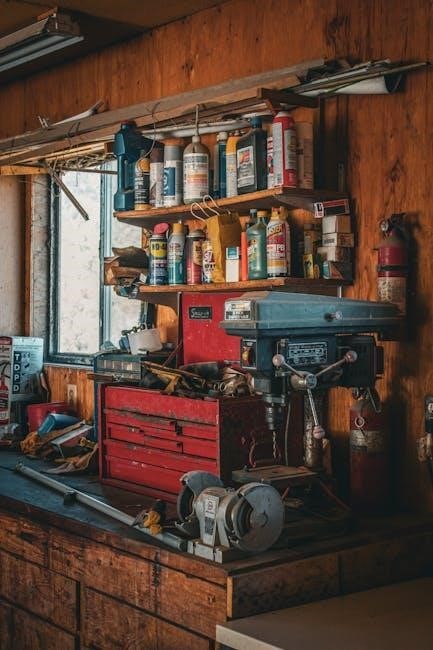Power to manual window conversion involves swapping power windows for manual operation, offering a cost-effective, reliable solution for those seeking simplicity and improved control over vehicle windows.
1.1 What is Power to Manual Window Conversion?
Power to manual window conversion is the process of replacing a vehicle’s power window system with manual operation. This involves removing the electric motor and installing a manual regulator and crank handle. It simplifies window operation, eliminates reliance on electrical systems, and offers a cost-effective solution for vehicles with non-functional power windows. The conversion is often sought for reliability, simplicity, and ease of maintenance.
1.2 Why Convert Power Windows to Manual?
Converting power windows to manual offers several advantages, including cost savings, reduced complexity, and improved reliability. Manual windows eliminate the need for expensive electrical components, making repairs simpler and more affordable. This conversion is ideal for vehicles with faulty power window systems or for those seeking a more straightforward, low-maintenance solution. It also appeals to enthusiasts of classic or older vehicles looking to retain functionality without modern dependencies.
Tools and Materials Required
The conversion process requires essential tools like screwdrivers, wrenches, and pliers, along with materials such as manual window regulators, cranks, and plastic window guides for smooth installation.
2.1 Essential Tools for the Conversion
The conversion requires screwdrivers, wrenches, pliers, and Torx or Allen wrenches for disassembly. A rivet gun and punches may be needed for removing rivets. Additional tools include a drill for hole alignment and a utility knife for trimming materials. Ensure all tools are readily available to streamline the process and avoid delays during installation.
2.2 Parts Needed for Manual Window Installation
Manual window regulators, window cranks, and mounting brackets are essential. Additional components include plastic window guides, screws, and clips. Ensure compatibility with your vehicle’s make and model. Some kits may require extra hardware, such as adapters or spacers, depending on the specific installation. Verify all parts are included in your conversion kit or purchase them separately to avoid delays.
Step-by-Step Conversion Process
Remove the power window motor and install a manual regulator. Mount the manual crank handle securely. Adjust the window alignment for smooth operation. Ensure all parts are properly secured and lubricated for optimal performance.
3.1 Removing the Power Window Motor
Start by disconnecting the electrical connectors attached to the power window motor. Remove the mounting bolts securing the motor to the window regulator assembly. Gently pull the motor away from the regulator, taking care not to damage any surrounding components. Once free, carefully lift the motor out through the door panel opening. This step is crucial for accessing the regulator and preparing for manual conversion.
3.2 Installing the Manual Window Regulator
Align the manual regulator with the existing window track and ensure it fits securely. Attach the regulator to the door frame using the provided mounting bolts. Tighten them firmly to prevent movement. Next, connect the window to the regulator’s roller and test the operation by turning the crank. Make sure the window moves smoothly and evenly. Proper alignment and secure fastening are key to reliable manual operation.
3.3 Mounting the Manual Crank Handle
Locate the correct position for the manual crank handle on the door panel, ensuring it aligns with the regulator. Mark the area for drilling and create a hole for the crank’s mounting bracket. Secure the bracket with screws and attach the crank handle. Test the crank’s operation to ensure smooth window movement. Apply lubricant to the track for frictionless operation and verify all components are tightly fastened for reliable performance.

DIY Kits for Power to Manual Conversion
DIY conversion kits provide everything needed to switch from power to manual windows, including regulators, cranks, and wiring harnesses, simplifying the process for enthusiasts and mechanics.
4.1 Overview of Conversion Kits
Conversion kits are designed to simplify the process of switching from power to manual windows. These kits typically include essential components such as manual window regulators, crank handles, and sometimes wiring harness adapters. They are tailored to fit specific vehicle models, ensuring compatibility and ease of installation. Kits vary in complexity, ranging from basic setups for older models to more advanced solutions for modern vehicles. They often include detailed instructions, making the transition accessible for DIY enthusiasts. By providing pre-assembled parts, conversion kits streamline the process, saving time and effort compared to sourcing individual components. This makes them a cost-effective and efficient choice for those seeking a reliable manual window system.
4.2 Choosing the Right Kit for Your Vehicle
Selecting the correct conversion kit is crucial for a seamless transition to manual windows. Consider your vehicle’s make, model, and year to ensure compatibility. Kits are often tailored to specific models, such as 2-door sedans or 4-door SUVs. Evaluate the number of doors and window regulators needed. Additionally, check if the kit includes wiring adapters or crank handles. Opt for a kit designed for your vehicle’s age and features to avoid compatibility issues. Read reviews and ensure the kit aligns with your DIY skill level. This ensures a smooth and efficient installation process, saving time and effort in the long run.

Common Challenges and Solutions
Power to manual conversion often presents wiring issues and alignment problems. Solutions include disconnecting power switches and adjusting window regulators to ensure smooth operation.
5.1 Dealing with Wiring and Switches
When converting to manual windows, disconnecting and removing power window switches is essential. This involves disabling the electrical system and ensuring no power flows to the motor. For vehicles with complex wiring, a professional may be needed to reroute or remove unnecessary circuits. Additionally, installing manual regulators often requires cutting holes for crank handles and ensuring proper alignment to maintain window functionality and safety.
5.2 Adjusting the Window Alignment
After installing manual regulators, ensure proper window alignment by loosening screws and adjusting the regulator’s position. Misaligned windows may not close smoothly or could leave gaps. Lubricate tracks to prevent sticking and test operation thoroughly. If issues persist, check regulator mounting points and glass guides for proper fit. Adjustments may require patience, but precise alignment is crucial for smooth, reliable window operation and long-term durability.

Cost Considerations
Power to manual window conversions vary in cost, depending on parts and labor. DIY kits can save money, while professional installations may incur higher fees, balancing budget and convenience effectively.
6.1 Budgeting for Parts and Tools
Budgeting for a power to manual window conversion involves estimating costs for manual regulators, window cranks, and tools like screwdrivers and wrenches. Parts can range from $50 to $200 per door, depending on quality and vehicle type. Tools are often reusable, but initial purchases may add $20 to $50. DIY kits, including regulators and cranks, can cost between $100 and $300, offering a cost-effective solution for enthusiasts. Researching specific vehicle needs helps allocate funds efficiently.
6.2 Labor Costs vs. DIY Savings
Professional labor for power to manual window conversion can range from $200 to $500 per door, depending on complexity and location. DIY projects eliminate these labor costs, saving hundreds. While parts may still be needed, the hands-on approach reduces expenses significantly. For those with basic mechanical skills, DIY offers substantial savings and the satisfaction of completing the job independently, making it a financially attractive option for budget-conscious enthusiasts.
Vehicle-Specific Tips and Tricks
Vehicle-specific tips involve ensuring compatibility with your car’s make and model. Older models may require less modification, while modern vehicles might need additional adjustments for smooth conversion.
7.1 Converting Power Windows in Older Models
Converting power windows to manual in older models is often simpler due to fewer electronic components. For instance, the BMW E36 can be converted using old manual regulators for around $100. Ensure compatibility by sourcing parts from similar models. Remove power motors, install manual regulators, and attach cranks. Lubricate tracks for smooth operation. This method is cost-effective and ideal for classic vehicles, providing a reliable solution without modern complexities.
7.2 Special Considerations for Modern Vehicles
Modern vehicles often require additional steps when converting power windows to manual. Advanced wiring and switches must be disabled or removed to prevent electrical issues. Ensure harness adapters are used to maintain proper connections. Some newer models may need custom solutions, such as retrofitting regulators or adjusting door panels. Compatibility and precise installation are crucial to avoid system conflicts and ensure smooth operation, especially in vehicles with integrated safety features and complex electronics.

Maintenance and Upkeep
Regular lubrication of manual window tracks ensures smooth operation. Check and maintain window alignment periodically to prevent wear. Clean tracks and apply silicone-based lubricant for optimal performance and longevity.
8.1 Lubricating Manual Window Tracks
Lubricating manual window tracks is essential for smooth operation. Use a silicone-based spray or grease to coat the tracks and rollers. Apply lightly, ensuring even coverage. Avoid heavy oils that attract dust. Wipe off excess with a clean cloth to prevent grime buildup. Regular lubrication reduces friction and wear, ensuring windows open and close effortlessly. Perform this maintenance every 6-12 months or when sticking occurs.
8.2 Ensuring Smooth Operation Over Time
Regular maintenance is key to ensuring manual windows operate smoothly. Inspect tracks for debris and clean them with a soft brush. Check crank handles for tightness and lubricate hinges periodically. Replace worn-out parts promptly, such as regulators or guides. Proper alignment is crucial, so adjust rollers if windows misalign. Consistent upkeep prevents jams and ensures longevity, keeping windows functioning like new for years to come.
Legal and Safety Considerations
Ensure manual window conversion complies with vehicle safety standards. Proper installation prevents liability issues and guarantees safe operation, maintaining roadworthiness and driver visibility.
9.1 Compliance with Vehicle Safety Standards
Compliance with vehicle safety standards is crucial for power to manual window conversions. Proper installation ensures unobstructed visibility and prevents potential hazards. Manuals must meet local regulations, especially regarding emergency egress and structural integrity. Using approved parts and correct procedures avoids legal issues and ensures passenger safety; Non-compliance can lead to failed inspections or accidents, making adherence essential.
9.2 Avoiding Potential Liability Issues
Avoiding liability issues in power to manual window conversions requires proper installation and adherence to safety guidelines. Ensure all modifications meet legal standards and maintain vehicle integrity. Documentation of the process and using approved parts can prevent legal disputes. Consulting professionals and following manufacturer instructions minimizes risks. Proper installation ensures functionality and safety, reducing potential liability claims. Always verify local regulations to avoid legal complications. Clear documentation and compliance are key to protecting against liability.

Troubleshooting Common Issues
Troubleshooting common issues in power to manual window conversions involves diagnosing sticking windows, damaged regulators, or wiring problems. Regular maintenance and inspections help prevent these issues.
10.1 Diagnosing Sticking or Jammed Windows
Diagnosing sticking or jammed windows involves checking for misalignment, debris, or worn-out parts. Inspect the window regulator, tracks, and rollers for damage. Clean or replace faulty components and ensure proper lubrication. If the window doesn’t move smoothly, the regulator may need adjustment or replacement. Regular maintenance and inspections can prevent such issues, ensuring smooth operation of manual windows over time.
10.2 Repairing Damaged Window Regulators
Repairing damaged window regulators involves removing the regulator assembly and replacing worn or broken parts. Inspect the tracks, gears, and cables for damage. Lubricate moving components and ensure proper alignment during reassembly. If the regulator is beyond repair, install a new one. Testing the window operation after repair is crucial to ensure smooth and consistent functionality. Properly fitted regulators prevent future issues and maintain reliable window performance.
Power to manual window conversion offers simplicity, reliability, and cost savings. While challenges exist, the satisfaction of a successful DIY project and improved vehicle functionality make it worthwhile for enthusiasts.
11.1 Final Thoughts on Power to Manual Conversion
Converting power windows to manual offers a practical solution for reliability and simplicity. While it requires effort, the satisfaction of a successful DIY project and long-term savings make it rewarding. For enthusiasts, it’s a testament to hands-on problem-solving, blending classic functionality with modern convenience. Ensure thorough planning and execution for optimal results, as this conversion can enhance your driving experience while reducing dependency on complex systems.
11.2 Encouragement for DIY Enthusiasts
Embrace the challenge of power to manual window conversion as a rewarding DIY project. With basic tools and patience, you can achieve a cost-effective solution while gaining hands-on experience. The sense of accomplishment and improved vehicle functionality make it a fulfilling endeavor. DIY enthusiasts will appreciate the simplicity and satisfaction of returning to manual operation, enhancing reliability and reducing reliance on complex systems. Join a community of like-minded individuals who value hands-on problem-solving and classic functionality.